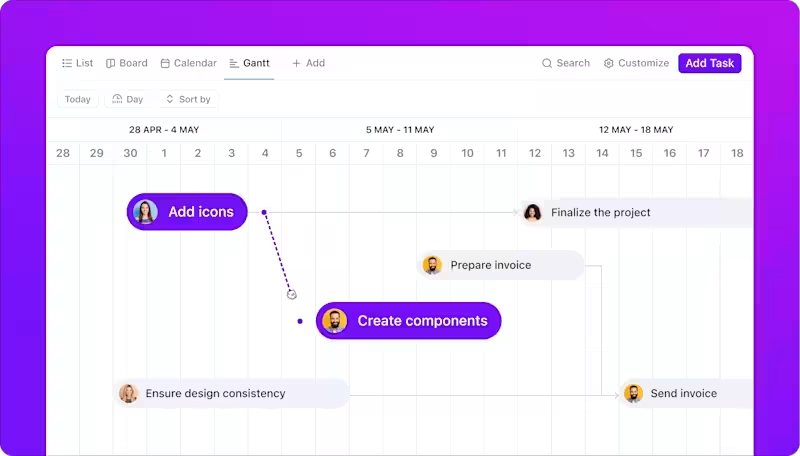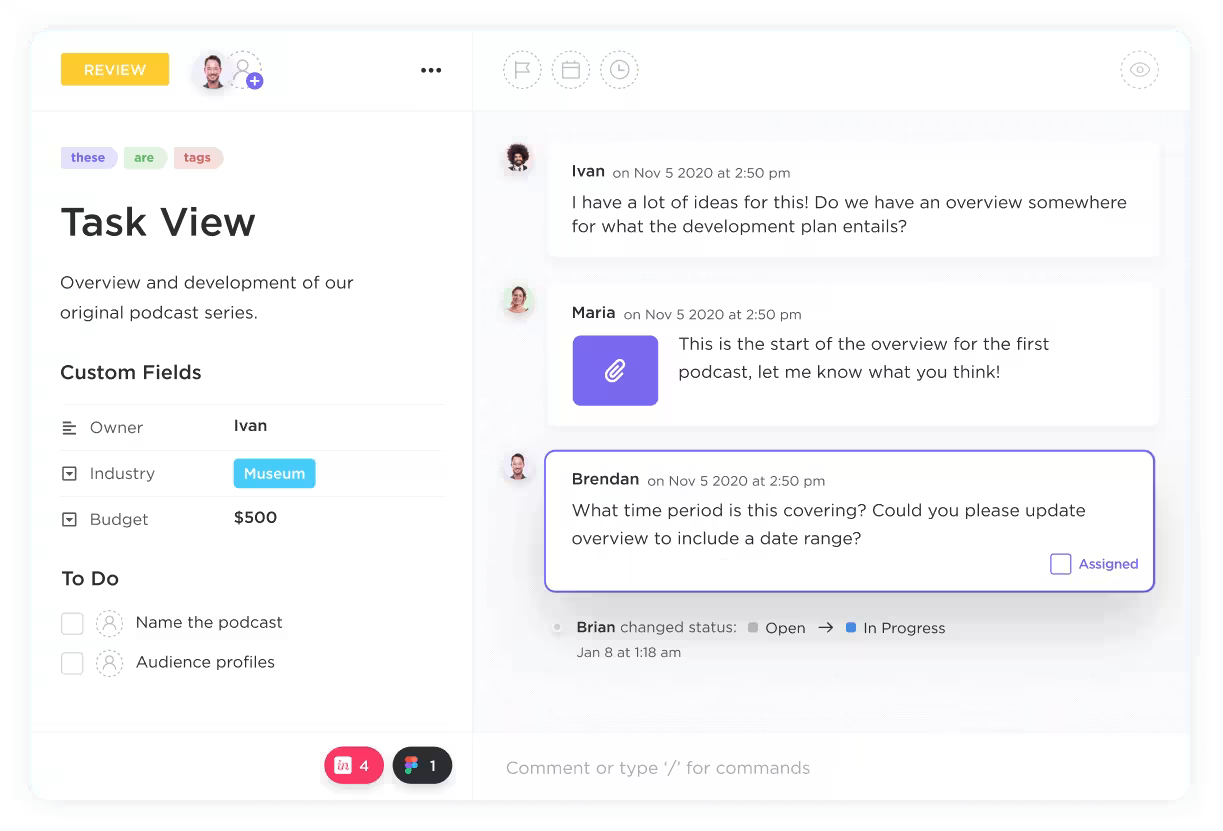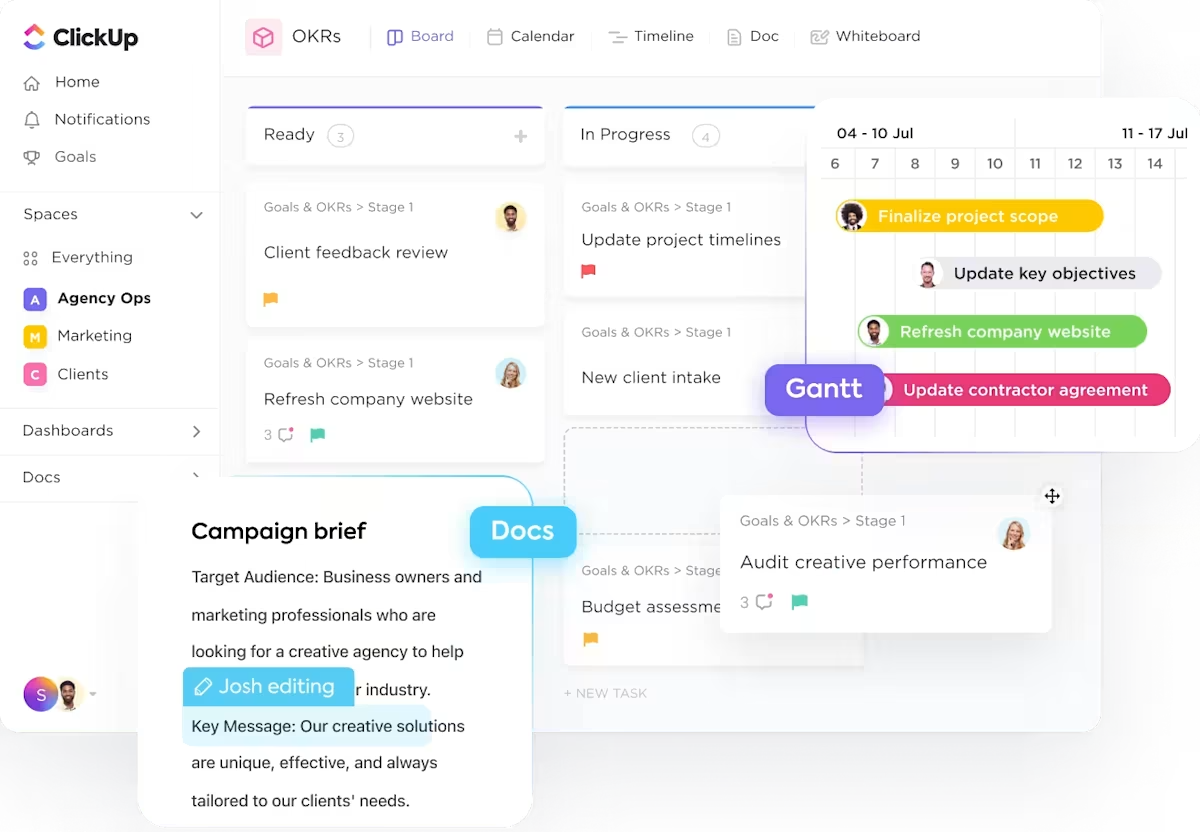Ever feel like your agency’s held together by crossed fingers and frantic Slack messages? Wrangling projects, delighting clients, and keeping your brilliant minds in sync can feel like herding particularly opinionated cats.
But what if there were a tool that could tame the chaos of agency life? Enter ClickUp, the productivity platform promising to turn your agency’s mess into a beautifully managed machine.
ClickUp offers a solution that can centralize your agency’s operations, eliminate the need to switch between multiple apps, reduce wasted time, and equip you with productivity tools.
Forget app-hopping and lost-in-the-ether tasks—we’re diving into how ClickUp’s features, real-world wins, and sneaky tips can help you streamline those workflows and finally get everyone rowing in the same direction.
Agency owners, let’s untangle this thing together.
What Is ClickUp?
Agency work is broken. Our client projects, knowledge, and communication are scattered across stand-alone tools, and the fragmentation of these tools, data, and processes worsens over time.
Equally important, as the competition heats up, it’s critical that you leverage every tech tool in your arsenal to provide services that are better, faster, and value-added.
ClickUp solves this with the everything app for work, bringing all your essential tools into one platform. It combines project planning, content creation, campaign tracking, CRM, Chat, and internal knowledge sharing so you can manage everything in one place.
ClickUp’s AI powers it and helps your agency work faster and smarter.
Results with ClickUp: 🚀 Learn how Amara, an inbound sales and marketing agency for STEAM businesses, uses ClickUp for Agency Project management. The CEO, Amara Omoregie, also explains how you can set it up for your agency.
Why Choose ClickUp for Agencies?
ClickUp solves the common challenges of digital agencies, such as managing multiple clients, improving team communication, CRM, and tracking project scope and progress.
Let’s look at the unique benefits of implementing ClickUp to transform agency and client workflows:
- Provides a centralized platform that lets digital agencies organize work by clients, teams, and projects through its intuitive hierarchy of Spaces, Folders, and Lists ✅
- Enhances team collaboration with features like comments, real-time chat, and shared documents. These encourage seamless discussions around projects, enabling teams to provide feedback and make decisions quickly ✅
- Allows digital agencies to monitor task statuses, deadlines, and team performance in real time, allowing for proactive adjustments to keep project management on track.
- The built-in time tracking feature ensures you can accurately bill clients for services rendered, enhancing financial control ✅
- Grows with your organization, supporting larger, more complex projects. With its competitive pricing model, digital agencies can start small and gradually scale up to more advanced functionalities as their business needs evolve ✅
- Offers AI-powered search through ClickUp Brain, indexing tasks, documents, and conversations so teams can instantly find the information they need ✅

Or use ClickUp AI to create pitch decks for you and custom images.

👀 Did You Know? ClickUp’s native and Zapier integrations let you connect with over 1,000 other apps. This means you can link ClickUp to your CRM, email marketing platform, and even your social media scheduler, creating a seamless flow of information.
For instance, you can eliminate manual data entry by automatically creating ClickUp tasks from new client leads in your CRM.
ClickUp vs. other popular tools for agencies
Here’s a brief comparison of ClickUp with some alternatives in the agency project management space:
| Feature | ClickUp | Trello | Asana |
| Supports hierarchical organization | ✅ Yes | Limited | Yes |
| Custom views | ✅ Yes | Limited | Yes |
| Time-tracking | ✅ Built-in | Requires integration | Requires integration |
| Customizable dashboards | ✅ Yes | No | Limited |
| Scalability | ✅ High | Moderate | Moderate |
| AI-enabled content generation | ✅ Yes | No | No |
| Pricing | ✅ Free forever plan, Customization options for enterprises | Free plan available; Paid plans start at $5/user/month* | Free plan available; Paid plans start at $10.99/user/month* |
While each platform offers valuable features, ClickUp differentiates itself with its unique combination of comprehensive functionality, intuitive interface, and competitive pricing.
📖 Also Read: Best Marketing Agency Software
Key Features of ClickUp for Agencies
ClickUp’s Creative Agencies Project Management Software has features specifically designed to address digital agencies’ unique needs.
Let’s explore some of its most powerful tools and how they can transform your agency’s workflows:
1. Client and project management
Use ClickUp Spaces to categorize departments or clients. Create Folders for individual clients within those Spaces. Add Lists inside each Folder for specific projects.

Leverage ClickUp Custom Fields to track client-specific information (e.g., industry, contact person) and project details (e.g., budget, target audience). Manage deliverables as tasks within your Lists, attach relevant files, and set due dates.

💡Pro Tip: Want more resources to enhance productivity, profitability, and workload management? Use ClickUp’s Project Management Resources for Agency Teams.
It offers the Big Book for Agency Project Management, several agency templates, webinars, and how-to guides.
2. Task assignments and dependencies
Agencies can assign ClickUp Tasks to team members, set deadlines, and create task dependencies to ensure smooth project execution.
Task dependencies are particularly useful for managing complex projects, as they ensure that specific tasks cannot be completed until prerequisite tasks are finished.

For example, if ‘Design Graphics’ can’t start until ‘Write Copy’ is finished, ClickUp makes tracking easy. View these dependencies visually in ClickUp’s Gantt Chart View to better understand your project flow.
You can also set up ClickUp Automations that trigger a change in Status or notify an assignee when a specific action occurs. It’s the best way to streamline workflows and manage project handoffs. But more on that below! 👇🏼
📮ClickUp Insight: 92% of workers use inconsistent methods to track action items, which results in missed decisions and delayed execution. Whether sending follow-up notes or using spreadsheets, the process is often scattered and inefficient.
ClickUp’s Task Management Solution ensures seamless conversion of conversations into tasks—so your team can act fast and stay aligned.
3. Custom Dashboards
Running a digital agency? Use ClickUp Dashboards to get an overview of projects, team workloads, and key performance metrics—in one centralized location.

Teams can monitor essential information in one centralized location by adding various cards, such as task statuses, time-tracking reports, and project timelines. This feature allows project managers to make rapid decisions based on real-time data.
4. Time tracking
ClickUp’s Time Tracking feature allows team members to log hours on specific tasks directly within the ClickUp platform. This feature helps digital agencies monitor time against budgets, time estimates, and deadlines.
Use ClickUp Timesheets to get a comprehensive report on time spent across tasks, ensuring better resource allocation and enabling projects to stay on schedule.

Did You Know? The mid-20th century saw the rise of iconic advertising campaigns created by legendary ad agencies and advertising professionals, a period often romanticized in popular culture, like the show “Mad Men.” This era was known for its creativity and the significant influence advertising held.
5. File sharing and collaboration
Your team can use ClickUp to simplify file sharing and collaboration. You can share files, updates, and feedback directly within tasks, attaching documents, images, or links to specific tasks, eliminating the need for back-and-forth emails.

The ClickUp Comments feature enables team members to leave feedback or ask questions. This centralized communication keeps discussions organized and directly tied to the work.
6. Streamlining agency processes
Creative agencies can simplify their workflows using ClickUp Automations and the dependencies feature. Create smart automations tailored to your unique processes without writing a single line of code.

Additionally, setting task dependencies ensures that team members understand the sequence of operations, preventing delays. ClickUp Goals allow digital agencies to align project management with broader objectives, tracking progress toward objectives in one place.
7. Templates for Agencies
ClickUp offers several templates specifically designed for creative agencies. These templates provide a structured starting point, allowing creative agency teams to customize them based on their needs:
💜 The ClickUp Content Calendar Template
The ClickUp Content Calendar template provides a visual overview of your agency’s content schedule, helping you plan, create, and publish content efficiently. It’s a central hub for all your content-related activities, ensuring everyone on the team is aligned and meeting deadlines.
Let’s say your agency is planning a month-long social media campaign for a new client. You can use the content calendar to map out posts across Instagram, Facebook, Twitter, and LinkedIn.
Each task on the calendar is a post, complete with details like copy, visuals, target audience, and publishing date. The calendar view gives you a big-picture look at the campaign, making it easy to spot any gaps or overlaps in your content strategy.
💜 The ClickUp Agency Management template
The ClickUp Agency Management Template gives your agency a ready-to-use structure for handling client onboarding, marketing plans, campaign execution, and reporting.
A standardized framework for projects, tasks, and resources keeps things organized and efficient, so your team can always deliver top-quality work.
Fun Fact: The first advertising agency in the United States was founded by Volney B. Palmer in 1841 in Philadelphia. His agency, the American Newspaper Subscription and Advertising Agency, initially focused on brokering advertising space in newspapers. Palmer is also credited with being the first to use the term “advertising agency.”
Organizing Work in ClickUp for Your Agency
Creating a well-planned agency management structure in ClickUp will save time and boost productivity in the long run.
Before you set it up, consider the following:
- Define your hierarchy: Determine how your agency is structured, including departments, teams, and individual roles
- Standardize naming conventions: To prevent confusion, establish clear and consistent naming conventions for clients, projects, tasks, and files. For example, use prefixes like ‘ClientName – ProjectName – TaskName’ or date-based conventions
- Identify key workflows: Document your agency’s core processes, from client onboarding to project delivery
- Consider integrations: Determine your agency’s tools (e.g., Slack, Google Drive) and plan how you’ll integrate them with ClickUp for a seamless workflow
Structuring your agency’s work in ClickUp using Spaces, Folders, and Lists
Think of your agency’s ClickUp workspace like a well-organized filing cabinet. Spaces act as the big drawers for major departments or functions. Inside each Space, Folders group related projects, and within those Folders, Lists hold the actual tasks.
By using ClickUp’s hierarchy of Spaces, Folders, and Lists, you can build a workspace tailored to your agency’s needs, keeping everything organized and easy to navigate.
Example: Marketing Agency
- Create three main Spaces

- Growth: For sales and content marketing efforts
- Delivery: For managing the output of client projects
- Administration: For HR and finance tasks

- Folders sit inside Spaces and help you group related projects or processes. Under the Delivery Space, you might have folders for:
- Projects: You can create folders for different service categories, such as campaigns, social media management, or website development
- Completed projects: Archive finished work for reference

- Inside each client or campaign folder, create Lists for
- Ongoing tasks: Current projects and their associated tasks
- Feedback requests: Tasks that require client input
- Deliverables: Final outputs are due to the client

Using this simple structure, you’ve created a clear hierarchy for your ongoing projects, making it easy to track progress and collaborate effectively.
Customizing views for different agency roles with Dashboards and cards
ClickUp Dashboards and cards let you create role-specific customized views so each team member sees precisely what matters to them.
ClickUp Dashboards and cards let you create role-specific customized views so each team member sees precisely what matters to them.
How to create a widget in ClickUp
- Access Dashboards: Navigate to the Dashboards section in ClickUp and select or create a dashboard. You can start from scratch or use a suitable template
- Add cards to the dashboard: Click the ‘Add card’ button to start. You can choose from various cards such as task lists, time tracking, charts, etc.
- Customize card: You can customize it to display the specific data you need. This includes setting filters, choosing data sources, and adjusting the display settings
- Save and share: Once your cards are set up, save your dashboard and share it with the relevant team members
Let’s look at how you can customize views for different agency roles using ClickUp’s Dashboards and widgets.
1. The agency founder’s big-picture overview
📊 Data needed: A snapshot of revenue, team performance, and key metrics.
💻 Dashboard setup:
- Profit and Loss Widget → Track revenue vs. expenses
- Time Tracking Widget → Analyze billable vs. non-billable hours
- Team Activity Widget → See who’s working on what in real time
🏆 Example scenario: The marketing agency founder logs in and sees that billable hours have dropped by 20% this month. With a few clicks, the founder checks the workload distribution, realizes too much time is spent on internal meetings, and decides to adopt a stand-up meeting format.
2. The creative team’s focused workspace
📊 Data needed: A streamlined view of assigned tasks without unnecessary details.
💻 Dashboard setup:
- Assigned Tasks Widget → Shows only their tasks with due dates
- Calendar View Widget → Visualize deadlines without switching tabs
- Comments and Updates Widget → Track feedback on creative assets in one place
🏆 Example scenario: A graphic designer logs in without digging through emails or Slack messages and sees their assigned client work for the week, with direct links to Figma files and client feedback.
3. The sales team’s deal tracker
📊 Data needed: A real-time pipeline of leads and client negotiations.
💻 Dashboard setup:
- CRM Table Widget → Track leads, deal status, and next steps
- Emails Widget → View client communications directly inside ClickUp
- Task Progress Widget → Track proposal and contract approvals
🏆 Example Scenario: The sales manager quickly filters the pipeline to see which proposals are pending approval. They notice a high-value client has stalled at the contract stage and can immediately follow-up.
💡 Friendly Reminder: You can share ClickUp Dashboards with any person or Team in your Workspace. Dashboards have access control options, so only stakeholders with whom you want to share data will be able to access it. How cool is that?
Training and Onboarding
Practical training and a smooth onboarding process are crucial for maximizing adoption and ensuring your business or agency gets the most out of implementing ClickUp.
1. Training your team on the ClickUp software and expectations
Before diving into projects, train your team on ClickUp.
ClickUp University offers a wealth of free resources, from short video tutorials to comprehensive courses, covering everything from basic navigation to advanced features.
Supplement this with live webinars, either pre-recorded or hosted by ClickUp, focusing on agency-specific use cases and workflows. Tailor the webinars to address the specific needs of internal stakeholders such as project managers, designers, or account managers.
Set clear expectations about how ClickUp will be used within the agency, including naming conventions, task management protocols, and communication guidelines.
2. Designing a smooth launch and migration plan
Identify a pilot team or project to test your ClickUp setup and workflows before rolling it out to the entire agency. This will allow you to iron out any kinks.
Data migration is another crucial aspect. If you’re migrating from another project management tool, carefully plan how to import your existing data into ClickUp to avoid losing valuable information.
Communicate the launch plan clearly to the entire agency, outlining the timeline, active work, training schedule, and support resources. Consider a phased rollout, starting with smaller teams and recurring tasks or projects before expanding to more complex ones.
3. Ensuring accountability after implementation with role assignment and permissions
Once ClickUp is live, ensuring accountability and maintaining data integrity is vital. Use ClickUp’s role assignment features to define who is responsible for each task and project.
As your agency grows, review user permissions regularly to ensure they’re still appropriate. This helps maintain data quality and ensures that ClickUp is used effectively across the agency.
Examples of Using ClickUp for Agencies
For instance, the ‘Eastern Spice’ restaurant project involves a rebranding and marketing campaign for a small Pan-Asian restaurant. The agency uses ClickUp to manage all aspects of this project, from initial planning to ongoing marketing efforts.
Here’s how ClickUp helps in different scenarios:
1. Campaign management
Your agency is launching a social media campaign for Eastern Spice’s grand opening.
ClickUp’s Project Management platform brings everything into one platform so you can focus on developing the best campaign.

Your team can use ClickUp Statuses to outline each stage (planning, content creation, ad setup, influencer outreach, grand opening event promotion), assign tasks to team members (copywriter, designer, social media manager, event coordinator), and track progress.
You can also leverage the Campaign and Promotion Management Template by ClickUp. It allows you to organize promotional tasks, track progress, and assess performance with customizable reporting tools.
2. Client reporting
The agency needs to show Eastern Spice’s owner the campaign’s performance. Using ClickUp CRM, you can create a ClickUp Dashboard with cards displaying key metrics (reach, engagement, website clicks, number of online reservations, and so on).

This live dashboard is shared with the client, providing transparent, real-time updates, eliminating the need for static reports, and promoting open communication.
The Marketing Agency Template by ClickUp can also provide a pre-built space to manage clients and campaigns. Track progress across all projects within one space.
3. Creative collaboration
The designer creates and uploads the logo and menu designs to the relevant ClickUp Task.
The client then uses ClickUp’s commenting feature to provide feedback directly on the image. They might use annotations on the image to highlight specific areas for revision. The designer then uploads revised versions, and the client uses ClickUp’s proofing features, like marking the task as ‘Approved,’ to formally sign off on the final design.
The marketing team can then use ClickUp’s Docs feature to collaborate on the website copy, using comments and version history to track changes and ensure brand consistency.
Additionally, the ClickUp Content Management Template can help develop an effective system for planning, organizing, and tracking the agency’s content.
4. Resource management
The agency’s project manager wants balanced workloads across the Eastern Spice team and can use ClickUp’s Workload View to see each team member’s assigned tasks and estimated time for all Eastern Spice-related activities.
This will allow the manager to make decisions such as outsourcing content generation tasks to external content writers if the internal team is overloaded, preventing burnout and ensuring the project stays on track.
ClickUp can also help manage other resources like equipment (cameras, studio space), budget allocation, and digital assets such as content marketing software.
5. Internal operations
The agency can use ClickUp to manage its internal content calendar planning, blog posts, case studies, and social media content.
For financial operations, it can track billable hours for each team member within ClickUp. ClickUp’s time tracking cards let you export detailed time data, which is also perfect for invoicing clients.
For the HR team, implementing ClickUp can help manage onboarding, track employee performance reviews, and manage time-off requests, all within the same platform.
This centralized approach to internal operations ensures everything runs smoothly, from project management to HR and finance.
Best Practices and Overcoming Common Challenges
By implementing the following best practices and proactively addressing potential challenges, you can ensure that ClickUp becomes an indispensable tool for your agency, driving efficiency, improving collaboration, and delivering better client results.
Best Practices
Here are some of the best practices that you should follow:
- Start small, scale up: Begin with a few key agency teams or projects and gradually expand your ClickUp usage as your team becomes comfortable with the platform ✔️
- Standardized templates: Use templates for repetitive work, projects, client onboarding, and proposals. This saves time, ensures consistency, and streamlines your workflows ✔️
- Establish clear communication protocols: Define how your team will communicate within ClickUp. Will you use comments, @mentions, or the chat feature? Setting clear guidelines prevents confusion ✔️
- Embrace automation: Explore ClickUp’s Automation features to streamline recurring processes such as task assignments, status updates, and report generation, freeing your team to focus on more strategic work ✔️
Overcoming common challenges
Here’s how you can overcome common challenges:
1. Information overload
‼️ This can manifest as too many tasks, notifications, and data points, leading to confusion and decreased productivity.
✅ To avoid this, use ClickUp Dashboards and ClickUp Views to filter and display only the most relevant data for each role.
2. Maintaining data accuracy
‼️ Inaccurate data can lead to flawed decision-making and project delays.
✅ Establish clear data entry protocols and regularly audit your ClickUp workspace to ensure the accuracy of information.
3. Integrating with existing tools
‼️ Tool integration involves connecting ClickUp with other software applications used by your organization. Challenges arise when integrations are complex, poorly planned, or encounter technical difficulties.
✅ To avoid this, carefully plan and test your integrations to ensure data flows smoothly via ClickUp’s API to other platforms.
Transform Your Agency’s Workflows with ClickUp
By implementing the strategies outlined in this blog post, your agency can leverage ClickUp to boost productivity, improve communication, and create customer delight.
From initial setup and workflow customization to leveraging dashboards and integrations, ClickUp provides the tools your agency needs to thrive.
By centralizing information, automating tasks, and providing real-time project insights, ClickUp lets your team focus on what matters most: delivering outstanding work for your clients.
Ready to transform your agency’s workflow and experience the power of ClickUp? Sign up for a ClickUp account for free today.






